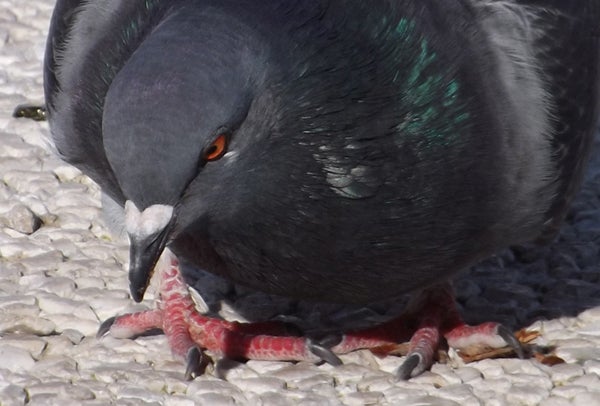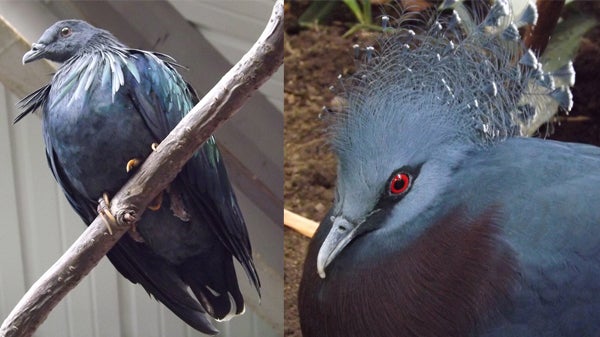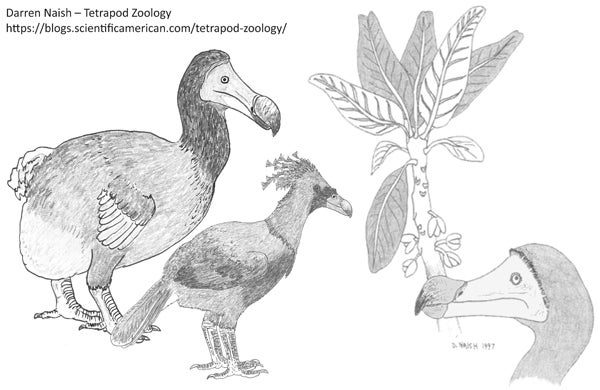This article was published in Scientific American’s former blog network and reflects the views of the author, not necessarily those of Scientific American
I’ve said many times at Tet Zoo that there are large groups of animals I’ve scarcely covered, or never even covered at all. Among these, perhaps, is Columbiformes, the pigeon clade… here are brief thoughts on the group as a whole, the text here combining material from my bird chapter in The Complete Dinosaur, Second Edition (Naish 2012) and unpublished stuff from The Vertebrate Fossil Record.

Feral pigeon photographed in Lisbon, Portugal. Feral pigeons are the descendants of domesticated Rock pigeons or Rock doves Columbia livia, a species native in its wild state to the coastal and mountainous regions of the Mediterranean, Asia Minor and the northern and western parts of Scotland and Ireland. This photo is interesting because the bird has its right foot turned inward so far that its hallux looks as if it’s on the outside edge of its foot. Credit: Darren Naish
Doves and pigeons are a globally distributed group of over 310 species. Distinctive characters include the presence of a cere (a soft, fleshy swelling around the nostrils), loosely rooted feathers, and the production of a milk-like substance from the crop that is fed to the young. The majority are perchers that sit and clamber on branches when foraging and feeding but some are semi-terrestrial and others completely so. Extant doves and pigeons have generally been included within the same family – Columbidae, the sole family within the order Columbiformes – though there is a history of recognising various subfamilies, the full list being Didunculinae, Gourinae, Carpophaginae, Otidiphabinae*, Treroninae, Ptilopodinae, Peristerinae, Phabinae, Caloenadinae and Columbinae (Janoo 1996). Furthermore, two recently extinct, turkey-sized columbiforms – the Dodo Raphus cucullatus of Mauritius and the Solitaire Pezophaps solitarius of Rodrigues – were typically given their own family (Raphidae) in the past. An improved understanding of columbiform phylogeny shows that they are deeply nested within Columbidae, and part of a clade that also includes Goura and Coloenas (Shapiro et al. 2002, Parish 2013).
On supporting science journalism
If you're enjoying this article, consider supporting our award-winning journalism by subscribing. By purchasing a subscription you are helping to ensure the future of impactful stories about the discoveries and ideas shaping our world today.
* Does anyone know why this isn’t Otidiphapinae when the taxon it’s named for is Otidiphaps?

A captive group of Diamond dove Geopelia cuneata – a granivorous, arid-adapted, Australian species – resting on the ground. Sociality and flocking is common in columbiforms but not ubiquitous. Credit: Darren Naish
The early fossil record of the group is poor, with the oldest specimen being from the Late Oligocene of Australia. The group has no Paleogene fossil record in the Northern Hemisphere as yet, and consequently it has been suggested that they evolved in the south and did not move into the north until after the Oligocene (Olson 1989). This is highly speculative, however, and questionable too, given the Northern Hemisphere presence of sandgrouse – the closest kin of columbiforms – in the Paleogene (I should note that some authors have included sandgrouse within Columbiformes).

Left: captive Nicobar pigeon Caloenas nicobarica (with badly overgrown claws). Right: Victoria crowned pigeon Goura victoria of New Guinea, one of three Goura species. Morphology and genetics show that both Caloenas and Goura are close kin of dodos and solitaires. Credit: Darren Naish
Ground living evolved several times within columbids. Members of Gourinae (the clade that includes the crowned pigeons Goura of New Guinea and the tooth-billed pigeons Didunculus of Samoa, Fiji, and Tonga) have repeatedly evolved large, flightless forms, the best known of which are the Dodo (which became extinct around 1690) and Solitaire (which was extinct by the 1760s). The Dodo and Solitaire both exhibited strong sexual dimorphism: male Solitaires weighed nearly 40% more than females. Solitaires possessed rounded bony clubs on their carpometacarpi that were used in combat. Dodo-like Natunaornis inhabited Fiji, but the White dodo of Réunion is almost certainly based on sightings of the extinct ibis Threskiornis solitarius.

Life reconstructions of Raphus and the smaller, Fijian Natunaornis, together with a depiction of a Dodo alongside a Tambalacoque tree Sideroxylon grandiflorum. As discussed in a previous Tet Zoo article, the once popular idea that Dodos existed in obligate mutualism with Sideroxylon is no longer considered valid. Credit: Darren Naish
The text prepared on this group of birds for my in-prep volume The Vertebrate Fossil Record is much longer and includes a far more detailed discussion on the pigeon fossil record. I’ve actually released that section of text at my patreon where you can see it in full, and help support this project and others. For previous Tet Zoo articles on pigeons, see…
Refs - -
Janoo, A. 1996. On a hitherto undescribed dodo cranium, Raphus cucullatus L. (Aves, Columbiformes), with a brief taxonomical overview of this extinct flightless Mascarene Island bird. Bulletin du Muséum national d’Histoire naturelle, Paris 4e série, 18, Section C, no 1, 57-77.
Olson, S. L. 1989. Aspects of global avifaunal dynamics during the Cenozoic. In Ouellet, H. (ed) Acta XIX Congresseus Internationalis Ornithologici, volume 2. University of Ottawa Press (Ottawa), pp. 2023-2029.
Shapiro, B., Sibthorpe, D., Rambaut, A., Austin, J., Wragg, G. M., Bininda-Emonds, O. R. P., Lee, P. L. M. & Cooper, A. 2002. Flight of the dodo. Science 295, 1683.